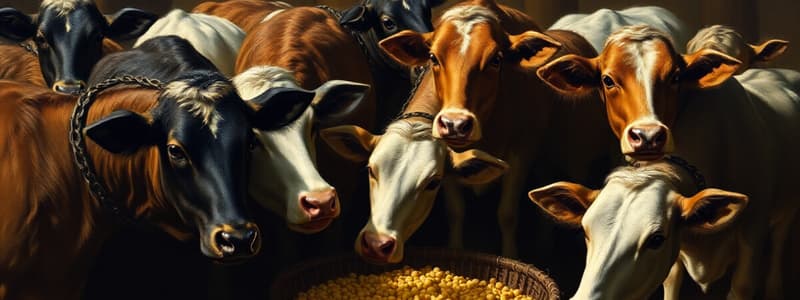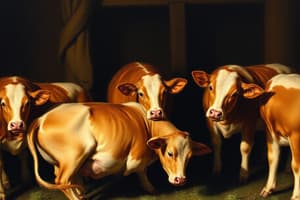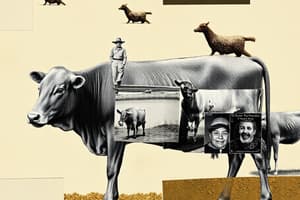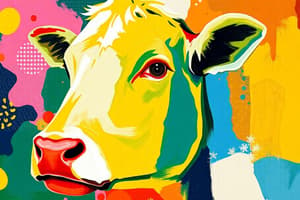Podcast
Questions and Answers
How do structural and non-structural carbohydrates differ in terms of composition and digestibility in livestock feed?
How do structural and non-structural carbohydrates differ in terms of composition and digestibility in livestock feed?
Structural carbohydrates like cellulose and lignin are found in forages and are less digestible. Non-structural carbohydrates like sugars and starches are found in grains and are more easily digestible.
Explain why the amino acid composition and digestibility of proteins are important considerations when evaluating the quality of protein sources for livestock.
Explain why the amino acid composition and digestibility of proteins are important considerations when evaluating the quality of protein sources for livestock.
Amino acid composition determines if all essential amino acids are present in adequate amounts to satisfy animal requirements. Digestibility determines how much of the protein the animal can absorb and utilize.
Why is it important to consider the level of fat in livestock diets, especially for ruminants, and what potential negative effects can arise from excessive fat?
Why is it important to consider the level of fat in livestock diets, especially for ruminants, and what potential negative effects can arise from excessive fat?
While fats are a concentrated energy source and aid in the absorption of fat-soluble vitamins, excessive fat, particularly in ruminants, can inhibit fiber digestion, reducing overall nutrient utilization.
Describe the roles of vitamin A, vitamin D, and vitamin E in livestock health, and explain why these vitamins are often supplemented in their diets.
Describe the roles of vitamin A, vitamin D, and vitamin E in livestock health, and explain why these vitamins are often supplemented in their diets.
What is the significance of macro-minerals and micro-minerals in livestock nutrition, and provide two examples of each along with their primary functions?
What is the significance of macro-minerals and micro-minerals in livestock nutrition, and provide two examples of each along with their primary functions?
Explain how Neutral Detergent Fiber (NDF) and Acid Detergent Fiber (ADF) are used in feed evaluation, and what information do they provide about the digestibility of feeds?
Explain how Neutral Detergent Fiber (NDF) and Acid Detergent Fiber (ADF) are used in feed evaluation, and what information do they provide about the digestibility of feeds?
Describe how ruminant animals utilize non-protein nitrogen (NPN) sources like urea, and why is this capability important in livestock nutrition?
Describe how ruminant animals utilize non-protein nitrogen (NPN) sources like urea, and why is this capability important in livestock nutrition?
What are anti-nutritional factors in livestock feeds, and how can processing methods like heat treatment mitigate their effects?
What are anti-nutritional factors in livestock feeds, and how can processing methods like heat treatment mitigate their effects?
Compare and contrast the digestive strategies of ruminant and monogastric animals, highlighting the key differences in how they process fiber and utilize nutrients.
Compare and contrast the digestive strategies of ruminant and monogastric animals, highlighting the key differences in how they process fiber and utilize nutrients.
Why is careful balancing of forages and concentrates essential for optimal animal nutrition, particularly in ruminant diets?
Why is careful balancing of forages and concentrates essential for optimal animal nutrition, particularly in ruminant diets?
Flashcards
Carbohydrates
Carbohydrates
The primary energy source for livestock, mainly from plant-based feeds, categorized as structural (fiber) and non-structural (sugars, starches).
Proteins
Proteins
Vital for tissue building, repair, and metabolic functions. Their quality depends on amino acid composition and digestibility.
Fats (Lipids)
Fats (Lipids)
Concentrated energy source, essential for absorbing fat-soluble vitamins and providing essential fatty acids.
Vitamins
Vitamins
Signup and view all the flashcards
Minerals
Minerals
Signup and view all the flashcards
Water
Water
Signup and view all the flashcards
Forages
Forages
Signup and view all the flashcards
Concentrates
Concentrates
Signup and view all the flashcards
Feed Processing
Feed Processing
Signup and view all the flashcards
Ruminant Nutrition
Ruminant Nutrition
Signup and view all the flashcards
Study Notes
- Livestock feeds contain various nutrient components essential for animal health, growth, and productivity.
- Key components include carbohydrates, proteins, fats, vitamins, minerals, and water.
Carbohydrates
- Primary energy source for livestock, derived mainly from plant-based feeds.
- Classified into structural (fiber) and non-structural (sugars, starches) types.
- Fiber includes cellulose, hemicellulose, and lignin, predominantly found in forages.
- Non-structural carbohydrates are easily digestible, present in grains and some processed feeds.
- Provide energy for bodily functions such as movement, maintaining body temperature, and physiological processes.
Proteins
- Vital for tissue building, repair, and various metabolic functions.
- Composed of amino acids, some of which are essential and must be supplied in the diet.
- Protein quality depends on amino acid composition and digestibility.
- Protein sources include soybean meal, fish meal, canola meal, and legumes.
- Ruminant animals can utilize non-protein nitrogen sources like urea, which rumen microbes convert into protein.
Fats (Lipids)
- Concentrated energy source, providing more energy per unit weight than carbohydrates or proteins.
- Essential for the absorption of fat-soluble vitamins (A, D, E, K).
- Provide essential fatty acids that animals cannot synthesize.
- Sources include vegetable oils, animal fats, and oilseeds.
- Excessive fat in diets can negatively affect fiber digestion in ruminants.
Vitamins
- Organic compounds needed in small amounts for various metabolic processes
- Classified as fat-soluble (A, D, E, K) and water-soluble (B vitamins, vitamin C).
- Vitamin A is important for vision, reproduction, and immune function.
- Vitamin D is essential for calcium absorption and bone metabolism.
- Vitamin E acts as an antioxidant and supports immune function.
- Vitamin K is necessary for blood clotting.
- B vitamins are involved in energy metabolism.
- Often supplemented in livestock diets to ensure adequacy.
Minerals
- Inorganic substances required for various physiological functions.
- Divided into macro-minerals (e.g., calcium, phosphorus, magnesium, potassium, sodium, chlorine, sulfur) and micro-minerals or trace minerals (e.g., iron, zinc, copper, manganese, iodine, selenium).
- Calcium and phosphorus are crucial for bone and teeth formation.
- Magnesium is involved in enzyme systems and nerve function.
- Potassium, sodium, and chlorine are electrolytes that regulate fluid balance.
- Trace minerals act as cofactors for enzymes and are involved in various metabolic pathways.
- Mineral deficiencies can lead to various health problems and reduced productivity.
Water
- Essential for all life processes, including nutrient transport, temperature regulation, and waste excretion.
- Animals obtain water from drinking water, feed moisture, and metabolic water.
- Water requirements vary depending on species, age, physiological state, and environmental conditions.
- Inadequate water intake can severely limit animal performance and health.
Feed Evaluation
- Evaluating nutrient content involves chemical analyses (proximate analysis, fiber analysis) and biological assays (digestion trials).
- Proximate analysis includes determining moisture, crude protein, ether extract (fat), crude fiber, and ash (minerals).
- Fiber analysis methods such as Neutral Detergent Fiber (NDF) and Acid Detergent Fiber (ADF) estimate the fiber content and digestibility of feeds.
- Digestion trials measure the digestibility of nutrients in vivo.
Nutrient Requirements
- Nutrient requirements vary depending on species, age, growth rate, reproductive status, and production level.
- Nutritional requirements are established by organizations like the National Research Council (NRC).
- Formulating balanced diets involves matching nutrient supply from feeds with the animal's nutrient requirements.
- Ration formulation considers factors such as feed availability, cost, and palatability.
Feed Additives
- Non-nutritive substances added to feeds to improve feed efficiency, growth rate, health, or product quality.
- Include antibiotics, probiotics, enzymes, antioxidants, and hormones.
- Antibiotics are used to prevent or treat diseases and improve growth rate; however, their use is increasingly regulated due to concerns about antibiotic resistance.
- Probiotics promote beneficial gut bacteria.
- Enzymes enhance the digestibility of specific feed components
- Antioxidants protect feeds from spoilage and can improve animal health.
Anti-Nutritional Factors
- Substances present in feeds that can reduce nutrient availability or have toxic effects.
- Examples include trypsin inhibitors in soybeans, gossypol in cottonseed, and tannins in certain forages.
- Processing methods such as heat treatment can reduce or eliminate the effects of some anti-nutritional factors.
Forages
- Plant-based feeds such as grasses, legumes, and silages.
- High in fiber and are a primary feed source for ruminant animals.
- Legumes (e.g., alfalfa, clover) have higher protein content than grasses.
- Silage is fermented forage preserved under anaerobic conditions.
Concentrates
- Energy-dense and/or protein-rich feeds.
- Include grains (e.g., corn, barley, wheat), oilseed meals (e.g., soybean meal, canola meal), and animal by-product meals (e.g., fish meal, meat and bone meal).
- Grains are high in starch and provide readily available energy.
- Oilseed meals are high in protein and are often used to supplement diets.
- Careful balancing of forages and concentrates is essential for optimal animal nutrition.
Feed Processing
- Methods used to alter the physical or chemical characteristics of feeds to improve digestibility, palatability, or handling.
- Include grinding, rolling, pelleting, extruding, and ensiling.
- Grinding and rolling increase the surface area of feeds, improving digestibility.
- Pelleting reduces dustiness and improves handling.
- Extruding involves cooking feeds under pressure, which can improve digestibility.
- Ensiling preserves moist forages through fermentation, creating silage.
Ruminant Nutrition
- Ruminant animals (e.g., cattle, sheep, goats) have a unique digestive system with a four-compartment stomach, including the rumen.
- Rumen microbes ferment feed, producing volatile fatty acids (VFAs), which are the primary energy source for ruminants.
- Rumen microbes also synthesize B vitamins and convert non-protein nitrogen into microbial protein, which the animal can digest.
- Understanding rumen function is crucial for formulating effective diets for ruminants.
Monogastric Nutrition
- Monogastric animals (e.g., pigs, poultry, horses) have a simple stomach and rely on enzymes for digestion.
- Monogastric diets need to supply all essential amino acids, vitamins, and minerals.
- Fiber is less digestible in monogastric animals compared to ruminants.
- Careful diet formulation is essential to ensure optimal growth and performance in monogastric animals.
Poultry Nutrition
- Poultry have high nutrient requirements due to rapid growth and egg production.
- Diets are typically based on grains (e.g., corn, wheat) and protein supplements (e.g., soybean meal).
- Calcium is particularly important for laying hens to support eggshell formation.
- Poultry diets often include supplemental vitamins and minerals to meet requirements.
Swine Nutrition
- Swine are monogastric animals with relatively high nutrient requirements.
- Diets are typically based on grains (e.g., corn, barley) and protein supplements (e.g., soybean meal).
- Amino acid balance is critical for optimal growth and feed efficiency.
- Swine diets often include supplemental vitamins and minerals to meet requirements.
Equine Nutrition
- Horses are non-ruminant herbivores with a functional hindgut (cecum and colon) where microbial fermentation occurs.
- Diets should be high in fiber, with forages (e.g., hay, pasture) making up a significant portion.
- Concentrates (e.g., grains) can be added to meet energy requirements, especially for working horses.
- Careful management of feeding practices is important to prevent digestive problems like colic and laminitis.
Pet Nutrition
- Dogs and cats have different nutritional needs based on their life stage, breed, and activity level.
- Dog's diets can be more varied, while cat's diets require specific nutrients like taurine.
- Commercial pet foods are formulated to meet the specific nutritional needs of pets.
- Understanding the specific nutritional requirements of each species is crucial for maintaining their health and well-being.
Studying That Suits You
Use AI to generate personalized quizzes and flashcards to suit your learning preferences.




